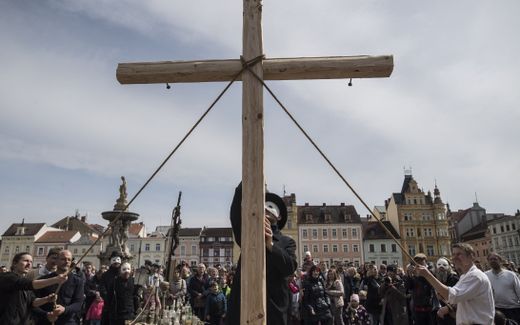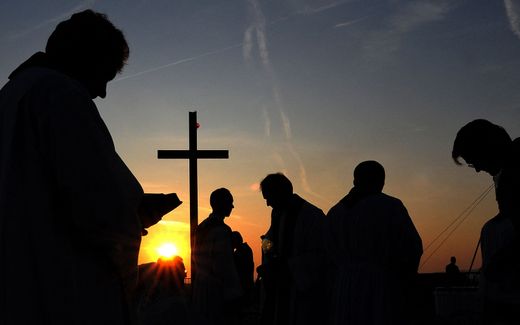Rise of early Christianity is evidence that Jesus rose again

Photo canva.com
Opinion
Millions of Christians have celebrated Easter this month. But many seekers and sceptics rightfully ask: did Jesus really rise from the dead? “The best explanation for the rise of Christianity after its founder’s public, humiliating death is that Jesus was truly risen.”
Stay up to date with Christian news in Europe? Sign up for CNE's newsletter.
Let’s imagine ourselves as seekers and sceptics. Here are four alternative theories that try to explain the rise of Christianity without the bodily resurrection of its founder.
The disciples visited the wrong tomb
Some sceptics affirm that the disciples must have visited the wrong tomb and, not seeing Jesus’s body, concluded that he had risen. Sounds like a simple explanation, right? But if that was the case, the authorities would have pointed to the proper grave and cleared up the confusion.
Jesus didn’t really die
Many Muslims, for instance, are taught that Jesus didn’t really die on the cross. “That they [the Jews] said, ‘We killed Christ Jesus the son of Mary, the Messenger of Allah’; but they killed him not, nor crucified him, but so it was made to appear to them” (Quran 4:157).
According to this perspective, Jesus may have fainted – but not died – on the cross. He was wrongfully buried, but after a few days, he regained consciousness and walked out of the grave, leading people to think that he had risen from the dead.
But the crucifixion was a public, visible death. Jesus didn’t die in secret, away from public attention and the scrutiny of his enemies. Friends and enemies alike saw him die in broad daylight. The first-century historian Tacitus recorded that “Christus, from whom the name [Christians] had its origin, suffered the extreme penalty during the reign of Tiberius at the hands of one of our procurators, Pontius Pilatus” (Annals, 15.44).
Another evidence of Jesus’s death was that when a soldier pierced Jesus’s side with a spear, blood and water came out of the wound (John 19:34). The separation of coagulated blood is medical evidence of death.
The biggest prank in history
A third alternative theory points to a titillating conspiracy theory: what if Jesus’s disciples stole his body and told everyone he was risen?
Matthew records that the Jewish authorities of the time were already so afraid of this possibility that they asked Pilate to provide extra security for his tomb. “‘Take a guard,’ Pilate answered. ‘Go, make the tomb as secure as you know how.’ So they went and made the tomb secure by putting a seal on the stone and posting the guard” (Matthew 27:65-66).
However, an even greater challenge to this theory is that the disciples gave their lives for this conviction. We might play a practical joke every now and then, but most of the apostles were tortured and killed for preaching that Jesus had risen. No one would die for a lie they consciously made up. The disciples were convinced that Jesus had really risen.
A series of collective hallucinations
A final alternative theory suggests that the disciples were so psychologically shocked after their Master’s death that they experienced hallucinations, thinking they had met Jesus afterwards.
This theory might have been possible if only one person had met the risen Jesus—maybe two people, to stretch it a lot. But Jesus appeared to hundreds of people, and he also appeared repeatedly to some of them. It is highly improbable that all of them had the same hallucination at the same time. It would have been a greater miracle than the resurrection itself!
Moreover, Jesus also appeared to those who opposed him, like Paul on the road to Damascus, who did not expect to encounter a risen Jesus. What transformed a man who persecuted Christians into the person who most spread the Christian faith? Paul’s answer is:
“For what I received I passed on to you as of first importance: that Christ died for our sins according to the Scriptures, that he was buried, that he was raised on the third day according to the Scriptures, and that he appeared to Cephas, and then to the Twelve. After that, he appeared to more than five hundred of the brothers and sisters at the same time, most of whom are still living, though some have fallen asleep. Then he appeared to James, then to all the apostles, and last of all, he appeared to me also, as to one abnormally born. For I am the least of the apostles and do not even deserve to be called an apostle, because I persecuted the church of God” (1 Corinthians 15:3-9).
Notice that Paul mentions several encounters witnessed by hundreds of people. Most of those eyewitnesses were alive at that point. It’s as if Paul is saying, “I didn’t want to meet Jesus. And if you are left with doubts, go ask the eyewitnesses. Most of them are still alive. They will tell you what they saw”.
The best explanation: Jesus’s bodily resurrection
The best explanation for the rise of Christianity after its founder’s public, humiliating death is that Jesus was truly risen. Can you think of any other historically acceptable explanation? No other theory, except a historical resurrection, adequately explains his disciples’ unshakable conviction in the risen Christ in the face of persecution and martyrdom. As N. T. Wright put it in The Resurrection of the Son of God, “That is why, as a historian, I cannot explain the rise of early Christianity unless Jesus rose again, leaving an empty tomb behind him.”
Related Articles










